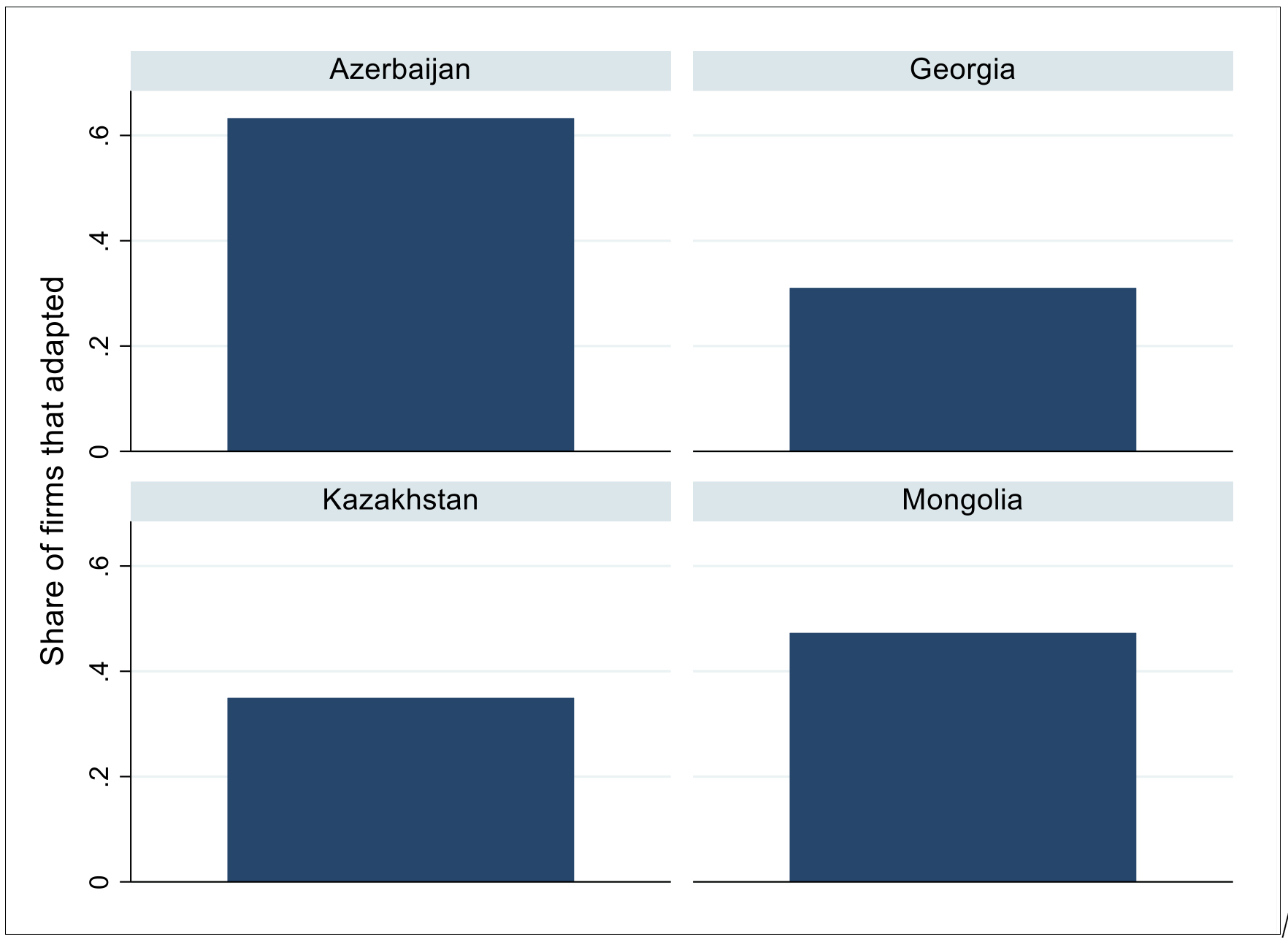
The coronavirus disease (COVID-19) outbreak has had wide-ranging impacts on the economies of Central Asia. Uncertainty and protective policy measures, such as lockdowns, social distancing, and travel restrictions, have led to falling demand and supply, causing unemployment, reduced working hours, loss of sales and income for businesses and households, restricted mobility, increased vulnerability, higher prices, and a lack of availability of staple items, among many others (Morgan and Trinh 2021). Empirical evidence on the impacts of COVID-19 in Central Asia is still scarce, but a new ADBI book published in collaboration with the Central Asia Regional Economic Cooperation (CAREC) Institute (Abdullaev et al. 2022) fills this gap with chapters that shed light on the consequences of the pandemic and the potential for recovery in the CAREC region, which extends from Azerbaijan to the People’s Republic of China and is an increasingly important channel for international trade and energy resources.
Nearly half of households reported income declines in the region
In order to better understand the pandemic’s consequences for households, a chapter by Azhgaliyeva et al. (2022) estimates the impact of COVID-19 on income, expenditure, and financial difficulty using data compiled from computer-assisted telephone interviews of households conducted in 10 economies from the CAREC region (excluding the People’s Republic of China) in December 2020 and June 2020. They find that nearly half of households (45%) reported income declines, while those with less-educated household heads were more likely to experience income declines due to COVID-19. Female-headed households were less likely to experience a decline in income, but households located in a lockdown area were more likely to experience declines in income and expenditure and to encounter financial difficulty. Households in the lowest socioeconomic class (i.e., the poorest group) were more likely to face financial difficulty than those in the highest socioeconomic class, and, on average, households with income from household businesses or self-employment were more likely to suffer from financial difficulty.
Female household heads are more inclined to adopt cleaner sources of residential heating
A further chapter in the new ADBI book explores the effects of the pandemic on household energy consumption in Mongolia by comparing data from the second wave of the UNICEF MICS Plus survey carried out during the pandemic (December 2020) with that from the pre-COVID-19 MICS survey from 2018 (Azhgaliyeva, Mishra, and Karymshakov 2022). The data show that in 2020, 60% of households used traditional cooking stoves for space heating, 83% of households used electricity for lighting, and 57% of households used solid fuel for cooking. The main heating energy types were coal (20 %), wood (20%), animal dung (17%) and improved fuel (13%). The empirical results show that households with female decision makers were more likely to have a clean source of heating, such as a district heating system. The results also show that a larger proportion of households switched to cleaner heating during the pandemic. First, the share of households using central heating increased in 2020 to 26% from 19% in 2018. Second, the share of households using improved fuel for their heating requirements increased in 2020 compared to 2018. Third, in December 2020, after the start of the pandemic, households were more likely to use district heating and manufactured space heaters than cooking stoves for heating compared to 2018.
Innovation, firm strategy, female managers, and government support help firms to adapt successfully to COVID-19
The book also includes analysis that examines the responses from the World Bank Enterprise Survey conducted in 2020 and 2021, which included questions related to COVID-19 and firm behavior during the pandemic, to analyze the factors affecting firms’ abilities to adjust production in response to the pandemic in four CAREC economies: Azerbaijan, Georgia, Kazakhstan, and Mongolia (Aseinov et al. 2022).
According to the data, the largest share of firms that adjusted their business activities was from Azerbaijan (around 60%), followed by Mongolia (around 40%) then Georgia and Kazakhstan (around 30% each) (Figure 1). The availability of external resources such as loans or government support can enhance a firm’s ability to cope with the negative impacts of a pandemic. The share of firms that had received government support for coping with the COVID-19 crisis or expected to receive it in the next 3 months from the state or local government in Azerbaijan was over 60%, and the least government support was reported in Kazakhstan, at less than 20%.
Figure 1. Share of Firms That Adapted (Adjusted or Converted) Production Due to COVID-19

Source: Aseinov et al. (2022).
The empirical findings indicate that firms that had adapted to the pandemic tended to be younger firms with foreign investment that were innovative in the recent past and that had a female manager, a formal firm strategy with key performance indicators, and their own websites. Overall, the results show that in the later rounds of the survey, firms were adapting to the new reality. Innovation and firm strategy, measured by the presence of a formalized, written business strategy with clear performance indicators, were important, and government support was also important, although its effect only appeared later in 2021.
Policy implications
The book’s findings have important evidence-based policy implications for policy makers in the CAREC region in supporting households and enterprises to cope and adapt amid the COVID-19 pandemic and in its aftermath.
In particular, the adoption of digital solutions in the CAREC region was central to sustaining economic activity during the pandemic. Going forward, greater efforts for harnessing the benefits of digitalization for the economy, including through promoting financial inclusion and reducing inequality, as well as access to clean energy and women empowerment, will be central to achieving a balanced, sustainable, and more resilient post-pandemic recovery in the region.
View the book preview video [2]
References
Abdullaev, Q. Abbas, D. Azhgaliyeva, G. Samad, and S. Akhmedov, eds. 2022. COVID-19 and Economic Recovery Potential in the CAREC Region [1]. Tokyo: ADBI.
Aseinov, D., B. Sulaimanova, K. Karymshakov, and D. Azhgaliyeva. 2022. What Determines the Adaptation of Enterprises to COVID-19 in CAREC Member Countries? Empirical Evidence from Azerbaijan, Georgia, Kazakhstan, and Mongolia. Chapter 6. In COVID-19 and Economic Recovery Potential in the CAREC Region [1], edited by I. Abdullaev, Q. Abbas, D. Azhgaliyeva, G. Samad, and S. Akhmedov. Tokyo: ADBI.
Azhgaliyeva, D., R. Mishra, and K. Karymshakov. 2022. Household Energy Consumption Behaviors During the COVID-19 Pandemic in Mongolia. Chapter 9. In COVID-19 and Economic Recovery Potential in the CAREC Region [1], edited by I. Abdullaev, Q. Abbas, D. Azhgaliyeva, G. Samad, and S. Akhmedov. Tokyo: ADBI.
Azhgaliyeva, D., R. Mishra, L. Q. Trinh, and P. Morgan. 2022. Impacts of COVID-19 on Households in CAREC Countries. Chapter 7. In COVID-19 and Economic Recovery Potential in the CAREC Region [1], edited by I. Abdullaev, Q. Abbas, D. Azhgaliyeva, G. Samad, and S. Akhmedov. Tokyo: ADBI.
Morgan, P. J. and L. Q. Trinh. 2021. Impacts of COVID-19 on Households in ASEAN Countries and Their Implications for Human Capital Development [3]. ADBI Working Paper 1226. Tokyo: Asian Development Bank Institute.